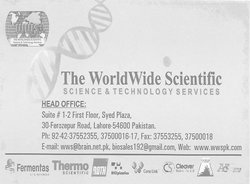Letter to Editor
Pediatric leukemia related depression in Pakistan
Nida Abdul Qadir, Hasnain Javed, Warda Fatima*
Adv. life sci., vol. 10, no. 1, pp. 29-30, March 2023
*- Corresponding Author: Warda Fatima (Email: warda.mmg@pu.edu.pk)
Authors' Affiliations
[Date Received: 24/01/2023; Date Published Online: 31/03/2023; Date Updated: 05/09/2025]
![]() The purpose of this letter is to describe the problems faced during and after treatment of pediatric leukemia. Depression and anxiety are the major challenges faced by children and their families. Antidepressants are used to cope with this problem, but they have many side effects. Therefore, timely diagnosis, supportive behavior from healthcare professionals and nurses, and positive psychological therapy may help reduce stress, the impact of social stigma, anxiety, and hopelessness in pediatric leukemia survivors. Implementing positive psychological therapy in government hospitals in Pakistan could improve recovery after chemotherapy and help pediatric leukemia patients achieve a stress-free life.
The purpose of this letter is to describe the problems faced during and after treatment of pediatric leukemia. Depression and anxiety are the major challenges faced by children and their families. Antidepressants are used to cope with this problem, but they have many side effects. Therefore, timely diagnosis, supportive behavior from healthcare professionals and nurses, and positive psychological therapy may help reduce stress, the impact of social stigma, anxiety, and hopelessness in pediatric leukemia survivors. Implementing positive psychological therapy in government hospitals in Pakistan could improve recovery after chemotherapy and help pediatric leukemia patients achieve a stress-free life.
Pediatric leukemia is the most prevalent malignancy in children under 18 years of age in Punjab, Pakistan. It is the most common cancer in children, in which the body produces abnormal immature lymphoblasts that do not mature into functional lymphocytes [1]. Leukemia is a group of disorders that affect blood-forming tissues such as the spleen, bone marrow, and lymphatic system. The term ‘leukemia’ means ‘white blood,’ referring to the abnormal proliferation of white blood cells (leukocytes). Blood cells are produced from stem cells through the process of hematopoiesis according to the body’s needs. In leukemia, either myeloid or lymphoid cell lineages are affected.
According to the Punjab Cancer Registry 2018 report, leukemia accounted for 3.5% of all cancers across age groups, 3.4% in adult males, and 14.9% of cancers in children under 18 years of age were acute lymphoblastic leukemia. This is a most common cancer among children in 2018 [1]. From 2018 to 2022, the incidence of leukemia increased across all age groups, accounting for 3.9% of all cancers and 25% of cancers in children ≤18 years of age, with acute lymphoblastic leukemia being the most common type [2].
Pediatric type of cancers such as leukemia are mostly treated by parental expenses and many variables related to family, are strongly associated with the health outcome, morbidity and mortality of children. Diagnosis and therapies may have profound psychological effects on the child and their family. Anxiety is the first significant problem faced by leukemic patients and their parents immediately after diagnosis, while depression often persists throughout treatment [3]. Cancer survivors often experience deep fears of loneliness, hopelessness, depression, anxiety, and social stigma. Family caregivers are the hidden sufferers of these psychological challenges. Their social, economic and emotional life are strongly disturbed and neurotic [4, 5]. The entire process, from the duration of treatment to survival after illness, is a challenging task for both parents and children, affecting them physically and psychologically and ultimately influencing family structure and function [6].
In many developing countries, including Pakistan, there is little formal care for this issue, this can lead towards depressed life even after successful treatment. Pharmacological treatments such as antidepressant drugs are used to treat depression. However, due to the side effects of antidepressants, patients often show poor adherence and prefer non-pharmacological treatments to reduce anxiety. Positive thinking interventions are among the most effective psychiatric approaches [7]. Positive psychotherapy relieves patients from stress by encouraging more positive emotions and meetings rather direct targeting the symptoms of depression and anxiety [8].
Positive psychological interventions and supportive behavior from healthcare professionals are effective approaches for cultivating positive behavior, emotions and cognition for healthy life in leukemia survival. psychoeducational programs can significantly increase hope in the child and family, supporting their return to a healthy and happy life after the difficult treatment process [9].
Routine mental health screening for anxiety and evaluation of parental functioning are important methods that help to identify the target patient with family who suffered with high level of depression. Psychological assessment surveys and distress thermometers may be useful tools for healthcare professionals during checkup for better evaluation [10]. A significant number of leukemia patients in different hospitals of Pakistan experienced significant psychological distress and depression. The Government of Pakistan should adopt these approaches, implementing positive psychological interventions in hospitals in different phases of cancer such as pediatric leukemia treatment, to help the child to cope with depression and escalating stress-free life expectancy.
Keywords: Leukemia; Depression
The authors declare that there is no conflict of interest.
References
- Punjab Cancer Registry Report-2018, http://www.punjabcancerregistry.org.pk, [date accessed 22 September 2019].
- Punjab Cancer Registry Report-2022, http://www.punjabcancerregistry.org.pk, [date accessed 06 March 2023].
- Myers RM, Balsamo L, Lu X, Devidas M, Hunger SP, Carroll WL, Winick NJ, Maloney KW, Kadan‐Lottick NS. A prospective study of anxiety, depression, and behavioral changes in the first year after a diagnosis of childhood acute lymphoblastic leukemia: a report from the Children's Oncology Group. Cancer, (2014); 120(9):1417-25.
- Hacialioglu N, Ozer N, Yilmaz Karabulutlu E, Erdem N, Erci B. The quality of life of family caregivers of cancer patients in the East of Turkey. European Journal of Oncology Nursing, (2010);14:211-7.
- Roche V. The hidden patient: Addressing the caregiver. American Journal of the Medical Science, (2009);337:199-204.
- Maurice‐Stam H, Oort FJ, Last BF, Grootenhuis MA. Emotional functioning of parents of children with cancer: the first five years of continuous remission after the end of treatment. Psycho‐Oncology: Journal of the Psychological, Social and Behavioral Dimensions of Cancer, (2008);17(5):448-59.
- Gartlehner G, Wagner G, Matyas N, Titscher V, Greimel J, Lux L, et al. Pharmacological and non-pharmacological treatments for major depressive disorder: Review of systematic reviews. BMJ Open, (2017);7:e014912.
- Seligman ME, Rashid T, Parks AC. Positive psychotherapy. American psychologist, (2006) ;61(8):774.
- Douki HE, Elyasi F, Hasanzadeh R. Effectiveness of positive thinking training on anxiety, depression and quality of life of mothers of children with leukemia. Journal of Nursing and Midwifery Sciences, (2019);6(1):21.
- Kazak AE, Barakat LP, Ditaranto S, Biros D, Hwang WT, Beele D, Kersun L, Alderfer MA, Mougianis I, Hocking MC, Reilly A. Screening for psychosocial risk at pediatric cancer diagnosis: the psychosocial assessment tool. Journal of pediatric hematology/oncology, (2011);33(4):289-94
This work is licensed under a Creative Commons Attribution-Non Commercial 4.0 International License. To read the copy of this license please visit: https://creativecommons.org/licenses/by-nc/4.0



